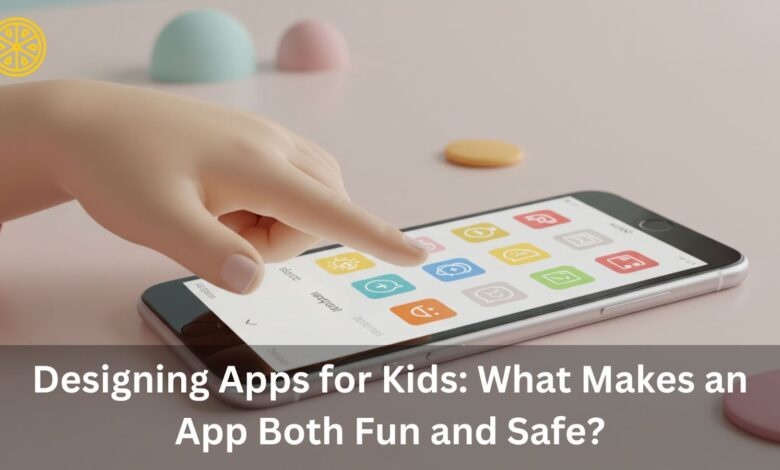Designing Apps for Kids: What Makes an App Both Fun and Safe?

When you think about designing apps for kids, what comes to mind? Is it just about creating something colorful and fun, or is there more to it? It’s a common question that many app developers face when building apps for younger audiences.
The truth is, designing an app for kids involves much more than just making it engaging. It requires an understanding of both entertainment and safety to ensure that children have a positive, secure experience while using the app. But how do you achieve that balance between fun and safety?
In this article, we’ll explore the key elements that make an app both fun and safe for kids. The challenge is finding that perfect mix of entertaining features that appeal to children, while also implementing robust safety features that protect their data and provide a secure environment for play and learning.
Why is App Design for Kids So Important?
The app design for kids is more than just creating an engaging interface. It involves building a system that not only captivates their attention but also encourages them to explore and learn. It’s a delicate balance between creating something enjoyable and ensuring that the content and environment are safe and appropriate for children.
One of the key benefits of designing a fun and safe app for kids is that it helps children develop new skills. Interactive apps can be a great educational tool, helping kids improve their problem-solving abilities, creativity, and cognitive skills.
Additionally, providing a safe app environment allows parents to feel confident about the content their children are consuming, making them more likely to recommend the app to others.
What Makes an App Safe for Kids?
When designing apps for children, safety should be a top priority. Ensuring that the app is free from inappropriate content, privacy risks, and security concerns is essential for building trust with both children and their parents. Here are some of the core safety features to include when developing an app for kids:
1. Data Privacy and Security
Protecting a child’s personal information is crucial when designing an app. Since children are often more susceptible to online threats, it’s essential to include privacy protection measures that prevent the collection of sensitive data, such as names, addresses, and location. Also, apps should be compliant with laws like COPPA (Children’s Online Privacy Protection Act), which governs the collection of information from children under 13.
- Why it’s important: Without proper data security and privacy measures, children’s information could be exposed to malicious third parties, potentially leading to identity theft or online predators.
- What to do: Implement strong data encryption protocols, don’t ask for unnecessary personal information, and be transparent about the data you do collect. Additionally, make sure to ask for parental consent before collecting any data from children.
2. Age-Appropriate Content
It’s essential to ensure that the content within the app is suitable for the child’s age group. Young children need simple, easy-to-understand content that doesn’t overwhelm them with too many complex elements. For older children, you may want to incorporate more challenging puzzles or games that help them develop problem-solving skills.
- Why it’s important: Providing age-appropriate content ensures that children have a positive experience while using the app, without exposure to inappropriate or confusing material.
- What to do: Develop content that matches the developmental stage of the child. Also, include content moderation tools to help prevent any inappropriate content from appearing.
3. In-App Purchases and Ads
One of the most important aspects of safety when it comes to children’s apps is controlling in-app purchases and advertisements. Many kids’ apps include in-app purchases that allow players to buy virtual items, which can quickly add up if not monitored properly. Furthermore, ads in apps may sometimes promote products or services that are inappropriate for children.
- Why it’s important: In-app purchases and ads can lead to unexpected costs or expose children to inappropriate content. Ensuring these elements are well-regulated or removed can enhance the safety of the app.
- What to do: Disable or limit in-app purchases to prevent accidental purchases. Additionally, avoid using third-party ads that might show unfiltered or inappropriate content. Consider using ads that are safe and age-appropriate or offer an ad-free experience for parents to purchase.
4. Parental Controls
Parents should have control over the app’s features and settings. For example, the ability to limit screen time, control what content can be accessed, or adjust privacy settings ensures that the app remains safe and enjoyable for children.
- Why it’s important: Parental controls give parents peace of mind, knowing that they can monitor or restrict certain app features to protect their children.
- What to do: Include customizable parental control settings that allow parents to limit screen time, access specific content, and prevent unintended purchases. Provide clear instructions on how to set up and use these features.
5. Clear Instructions and Support
Kids need clear instructions that guide them on how to navigate the app. If an app is too complicated or lacks guidance, children may become frustrated and lose interest. Additionally, it’s important to provide accessible customer support for both kids and parents in case any issues arise.
- Why it’s important: Easy-to-follow instructions help children enjoy the app without feeling overwhelmed. Clear support options also ensure that any technical difficulties can be quickly addressed.
- What to do: Provide easy-to-understand instructions and tutorials within the app. Additionally, ensure that there is a reliable support system in place to handle inquiries from parents or kids.
How to Make an App Fun for Kids?
Fun is the key to keeping children engaged in an app. While safety and security features are non-negotiable, the app’s entertainment value is what ultimately encourages children to keep playing and learning. Here are some ideas to make your app more enjoyable for kids:
1. Interactive Features
Kids love apps that allow them to interact with elements on the screen. Whether it’s tapping objects, dragging and dropping items, or solving puzzles, adding interactive elements makes the app more engaging and enjoyable.
- Why it’s important: Interactive features promote learning and keep kids entertained. They help develop hand-eye coordination and problem-solving skills while providing a sense of achievement.
- What to do: Incorporate fun mini-games, puzzles, or interactive stories. Rewarding kids with achievements or virtual stickers can also increase their excitement to keep playing.
2. Colorful and Engaging Visuals
Kids are drawn to bright, colorful designs and playful animations. Using fun visuals that appeal to their sense of creativity helps keep their attention focused on the app.
- Why it’s important: Visually appealing apps are more likely to captivate children’s attention and keep them engaged for longer periods.
- What to do: Use a colorful and child-friendly design with large buttons, fun animations, and cute characters. Make sure the design is simple and easy to navigate so that children can explore without frustration.
3. Gamification and Rewards
Gamification is a powerful tool in app design for kids. By turning the learning experience into a game, kids are more motivated to interact with the app and progress through the content.
- Why it’s important: Gamified elements like badges, levels, and points can keep children motivated and excited to learn. This approach turns learning into a fun and rewarding experience.
- What to do: Create a rewards system that offers virtual prizes for completing tasks, reaching milestones, or solving puzzles. This will encourage children to keep using the app and improve their skills.
4. Educational and Entertaining Content
Kids’ apps don’t just need to be fun; they should also offer value in the form of learning opportunities. Whether it’s teaching basic math, science, or language skills, apps can be both entertaining and educational.
- Why it’s important: Educational content helps children learn while having fun, providing them with valuable skills that can support their academic development.
- What to do: Design educational games that focus on key learning areas such as letters, numbers, shapes, colors, or even more advanced subjects like coding. Balance the learning experience with fun activities to keep kids engaged.
5. Easy Navigation
Children, especially younger ones, can get frustrated if an app is difficult to navigate. A user-friendly interface ensures that kids can easily explore the app and enjoy the experience without getting stuck or confused.
- Why it’s important: Simple navigation helps kids get the most out of the app and prevents frustration. It’s essential for creating a positive user experience.
- What to do: Use large buttons, clear labels, and simple gestures like swiping or tapping. Make sure that kids can easily find what they’re looking for and enjoy the app without unnecessary obstacles.
Conclusion
Designing apps for kids is a unique challenge that requires balancing fun, educational value, and safety. With thoughtful app design for kids, you can create an engaging and secure experience that both children and parents will appreciate.
By ensuring data privacy, offering age-appropriate content, implementing parental controls, and adding interactive, entertaining elements, you can create an app that is both enjoyable and secure for young users.
By considering these factors in the design process, you can provide kids with a safe environment to explore, learn, and have fun—while giving parents the peace of mind that comes with knowing their children are protected.




